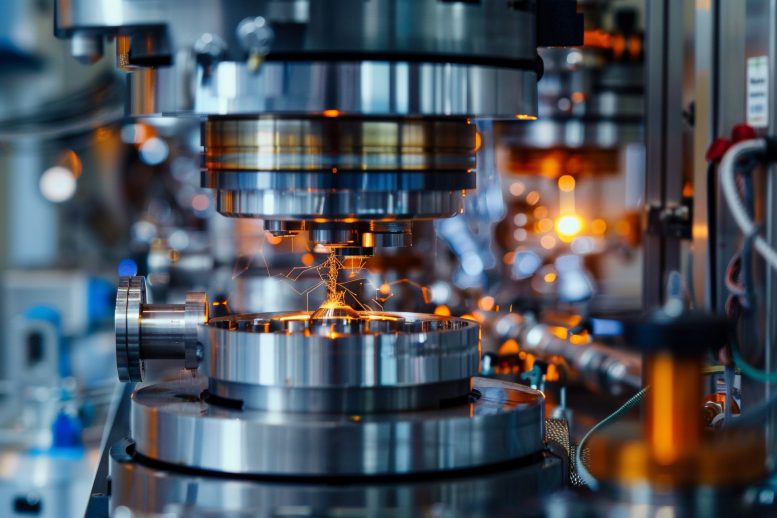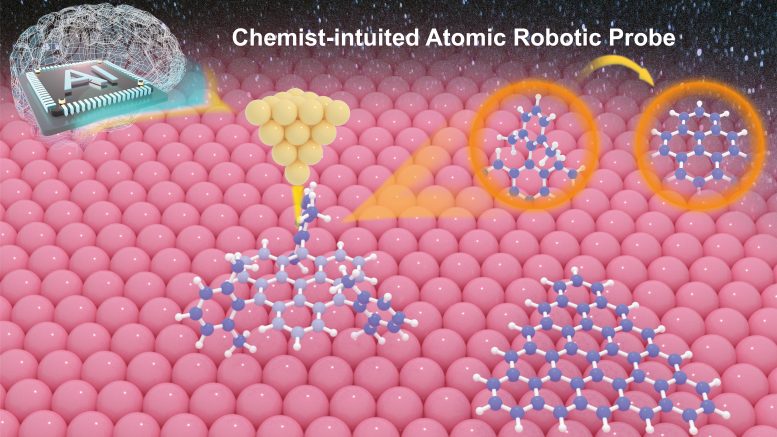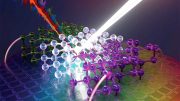
Scientists from the NUS have created a novel method for fabricating quantum materials at the atomic scale using AI, offering significant advancements in the control and production of these materials for research and practical applications. This method, involving the CARP concept, demonstrates the potential for AI to revolutionize atomic manufacturing and quantum material research. (Artist’s concept). Credit: SciTechDaily.com
Researchers at the National University of Singapore (NUS) have developed an innovative method for creating carbon-based quantum materials atom by atom. This method combines the use of scanning probe microscopy with advanced deep neural networks. The achievement underlines the capabilities of artificial intelligence (AI) in manipulating materials at the sub-angstrom level, offering significant advantages for basic science and potential future uses.
Open-shell magnetic nanographenes represent a technologically appealing class of new carbon-based quantum materials, which host robust π-spin centers and non-trivial collective quantum magnetism. These properties are crucial for developing high-speed electronic devices at the molecular level and creating quantum bits, the building blocks of quantum computers.
Despite significant advancements in the synthesis of these materials through on-surface synthesis, a type of solid-phase chemical reaction, achieving precise fabrication and tailoring of the properties of these quantum materials at the atomic level has remained a challenge.

The figure illustrates the chemist-intuited atomic robotic probe that would allow chemists to precisely fabricate organic quantum materials at the single-molecule level. The robotic probe can conduct real-time autonomous single-molecule reactions with chemical bond selectivity, demonstrating the fabrication of quantum materials with a high level of control. Credit: Nature Synthesis
The CARP Concept
The research team, led by Associate Professor Lu Jiong from the NUS Department of Chemistry and the Institute for Functional Intelligent Materials together with Associate Professor Zhang Chun from the NUS Department of Physics, have introduced the concept of the chemist-intuited atomic robotic probe (CARP) by integrating probe chemistry knowledge and artificial intelligence to fabricate and characterize open-shell magnetic nanographenes at the single-molecule level. This allows for precise engineering of their π-electron topology and spin configurations in an automated manner, mirroring the capabilities of human chemists.
Demonstration of the AI-driven chemist-intuited atomic robotic probe. Credit: Nature Synthesis
The CARP concept, utilises deep neural networks trained using the experience and knowledge of surface science chemists, to autonomously synthesize open-shell magnetic nanographenes. It can also extract chemical information from the experimental training database, offering conjunctures about unknown mechanisms. This serves as an essential supplement to theoretical simulations, contributing to a more comprehensive understanding of probe chemistry reaction mechanisms. The research work is a collaboration involving Associate Professor Wang Xiaonan from Tsinghua University in China.
Publication and Potential
The research findings were recently published in the journal Nature Synthesis.
The researchers tested the CARP concept on a complicated site-selective cyclodehydrogenation reaction used for producing chemical compounds with specific structural and electronic properties. Results show that the CARP framework can efficiently adopt the expert knowledge of the scientist and convert it into machine-understandable tasks, mimicking the workflow to perform single-molecule reactions that can manipulate the geometric shape and spin characteristic of the final chemical compound.
In addition, the research team aims to harness the full potential of AI capabilities by extracting hidden insights from the database. They established a smart learning paradigm using a game theory-based approach to examine the framework’s learning outcomes. The analysis shows that CARP effectively captured important details that humans might miss, especially when it comes to making the cyclodehydrogenation reaction successful. This suggests that the CARP framework could be a valuable tool for gaining additional insights into the mechanisms of unexplored single-molecule reactions.
Assoc Prof Lu said, “Our main goal is to work at the atomic level to create, study, and control these quantum materials. We are striving to revolutionize the production of these materials on surfaces to enable more control over their outcomes, right down to the level of individual atoms and bonds.
“Our goal in the near future is to extend the CARP framework further to adopt versatile on-surface probe chemistry reactions with scale and efficiency. This has the potential to transform conventional laboratory-based on-surface synthesis process towards on-chip fabrication for practical applications. Such transformation could play a pivotal role in accelerating the fundamental research of quantum materials and usher in a new era of intelligent atomic fabrication,” added Assoc Prof Lu.
Reference: “Intelligent synthesis of magnetic nanographenes via chemist-intuited atomic robotic probe” by Jie Su, Jiali Li, Na Guo, Xinnan Peng, Jun Yin, Jiahao Wang, Pin Lyu, Zhiyao Luo, Koen Mouthaan, Jishan Wu, Chun Zhang, Xiaonan Wang and Jiong Lu, 29 February 2024, Nature Synthesis.
DOI: 10.1038/s44160-024-00488-7








This allows for precise engineering of their π-electron topology and spin configurations in an automated manner, mirroring the capabilities of human chemists.
very good!
Please consider:
1. Can spin create everything?
2. Is spin related to gravitation?
3. Where does spin come from?
4. Where do topological vortices come from?
5. Are topological vortices two-dimensional spacetime matter?
6. What is the spatiotemporal basis for the formation of topological vortices?
and so on.
The universe does not do algebra, formula or fraction. The universe is geometrythe,and is the superposition, deflection, and twisting of geometric shapes.
Today, we have already entered the era of the internet. With the help of artificial intelligence and big data, discussions on scientific knowledge have become open and transparent. However, a group of editors of so-called academic journals (such as Physical Review Letters, Nature, Science, etc.) are self-righteous and mystifying themselves. They only care about their own so-called sufficiently high priority rating, general significance, discipline, novelty, etc., and do not care about what science and pseudoscience are.
Science and pseudoscience are not determined by a publication, an organization or a person, nor by you or me, but by mathematics the final say. Physical models must be based on mathematics or mathematical models in order to be scientific, convincing, and in accordance with natural laws.
The origin of geometry lies in the concerns of everyday life. The branch of geometry (mathematics) known as topology has become a cornerstone of modern physics. Topological vortex and antivortex are two bidirectional coupled continuous chaotic systems. They exhibit parity conservation, charge conjugation, and time reversal symmetry. The synchronization effect is extremely important in their interactions. The synchronization effect of the superposition, deflection, and twisting of multiple or countless topological vortices will make spacetime motion more complex. To understand this complex world, physics should respect the authenticity of topological vortex in low dimensional spacetime, rather than simply relying on a few formulas, numbers, or imagined particles.
Spin is a natural property of topological vortices. Spin is synchronized with energy, spin is synchronized with gravitation, spin is synchronized with time, spin is synchronized with evolution. The perpetually swirling topological vortices defy traditional physics’ expectations. One physical properties of topological vortices is them to spontaneously begin to change periodically in time, even though the system does not experience corresponding periodic interference. Therefore, in the interaction of topological vortices, time is both absolute and relative,and physics often requires treating space and time at the same level.
Low-dimensional spacetime matter is the foundation of high-dimensional spacetime matter. Low-dimensional spacetime matter (such as topological vortex) can form new material structures and derive more complex physical properties via interactions and self-organization. It is extremely wrong and irresponsible to imagine low dimensional spacetime matter using high-dimensional spacetime matter,such as a cat in quantum mechanics.
Science must follow mathematical rules. For example, the Standard Model (SM) is considered to be one of the most significant achievements of physics in the 20th century. However, the magnetic moment of μ particle is larger than expected, revealed by a g-2 experiment at Fermilab, suggests that the established theory (such as SM) of fundamental particles is incomplete. Furthermore, the SM omitting gravitation, it not involved the time problem and when the particle movement starts. Mathematics is the foundation of science. Physics must respect the scientific nature of mathematics and mathematical models. The SM must be based on mathematical models in order to be scientific, convincing, and in line with natural laws.
I hope researchers are not fooled by the pseudoscientific theories of the Physical Review Letters (PRL), and hope more people dare to stand up and fight against rampant pseudoscience.
The so-called academic journals (such as Physical Review Letters, Nature, Science, etc.) firmly believe that two high-dimensional spacetime objects (such as two sets of cobalt-60) rotating in opposite directions can be transformed into two objects that mirror each other, is a typical case of pseudoscience rampant.
If researchers are really interested in Science and Physics, you can browse https://zhuanlan.zhihu.com/p/643404671 and https://zhuanlan.zhihu.com/p/595280873.
I am well aware that my relentless repetition can make some people unhappy, but in the fight against rampant pseudoscience, that’s all I can do.
A word to the wise: if you want someone to read your stuff, keep it short and sweet. Kisses!
Mathematics is a way of describing the physical world; the description must conform to the reality, not the other way around. Your rant does sound like pseudoscience.
All I see here is AI-powered fabrication of “news”.